The human brand: Moving towards authenticity in healthcare

David Harvey, creative director at Langrand, discusses the merits of a move toward authenticity in healthcare marketing.
Why do we feel, live and buy the way we do? In his book The Culture Code, renowned marketing expert Clotaire Rapaille explores how these answers are “encoded” into our very humanity, shaped by our upbringing and manifested in the ways we think about the world.
Take his own example. According to Rapaille, the Jeep Wrangler codes not to SUV but to horse – in other words, consumers connect more deeply with Jeep as an iconic figure of the American frontier. (He even credits this insight for influencing the vehicle’s trademark round headlights, evoking a horse’s eyes.)
Rapaille’s code for health in America? Movement.
“For Americans, health and wellness means being able to complete your mission,” he argues. “The mission might be running a multinational corporation, getting the kids off to school, participating in local politics, scaling a mountain or cooking a great meal for your family, but it involves action.”
This is why the health of superstar athletes is defined by return-to-play windows or, to use another example from the book, why retirees often grow restless once their working days are over. Moving, doing anything, helps us feel active, healthy and alive.
It’s as authentically human as it gets.
Marketing the human condition
The lesson here isn’t merely psychobabble or idle theorising – for humans, movement is entirely on-brand. Look no further than Nike, which for decades has planted its flag in the idea of the athlete in all of us, or a Huggies brand that is all about keeping your baby cared for and comfortable as they move around the world for the very first time.
The lasting images from these brands are more than shoes and diapers. People want to buy into an active lifestyle defined by freedom of movement, no matter how many miles (or how fast) they run. Where Huggies appears to be marketing its latest design, what they’re really keying in on – the code they’re tapping into – is healthy babies. For parents, that isn’t a hard sell.
A dose of reality
If only it were so simple. Think pieces on the “ever-changing healthcare landscape” abound. (Google will back me up on this.) Every corner of the industry, from hospitals to home-delivered medications, has its own regulatory hurdles to overcome – marketing and otherwise. Healthcare institutions, by their nature, are slow-moving.
To a certain degree, you also have to sell the product you have. There are only so many ways to tout nationally ranked service lines or new technologies without coming across as boastful or inauthentic. And, at the risk of sounding cynical, it’s not hard for marketers to turn to “shiny new objects” as fodder to differentiate and get patients in the door.
As the business of health continues to embrace this shiny future (I’m looking at you, AI), we would all do well to remember what makes health human.
Moving the authenticity needle
Luckily, it’s not an all-or-nothing proposition. You can hang that “Best Cardiovascular Care” banner and focus on human storytelling, so long as we don’t conflate the two. People need to know where the nearest emergency room is, after all, or compare hospitals before deciding on a course of treatment. That’s basic awareness, straight out of Marketing 101.
For authenticity, creators and storytellers should rightly take a different tack. The healthcare industry has no shortage of success stories – a surgery gone well, a revolutionary technology, a life-saving treatment. Instead of opting for traditional talking head testimonials, for example, content approaches can focus on people outside hospital walls, living their lives as people, not patients. Completing their mission, per Rapaille.
The same goes beyond the marketing sphere. Those working in health can use the Movement code to inform how they deliver authentic human experiences for patients and consumers, such as redesigning waiting rooms and parking facilities.
At heart, the question is quite simple, no decoding required:
How does our brand align with the human brand?













